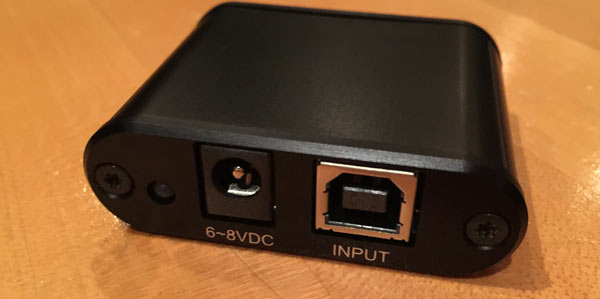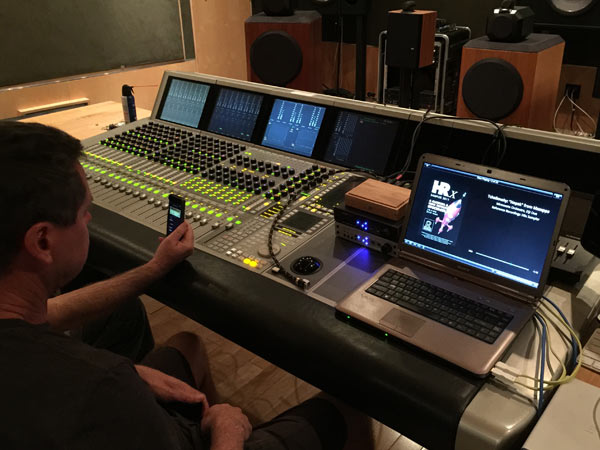Russ Stratton Shares His Notes on The Regen Session
Mark Waldrep and I have been friends for many years through our mutual participation in the Los Angeles & Orange County Audio Society. I‘ve followed his recent debate with Michael Lavorgna over the Uptone USB Regen with some amusement. I had a chance to meet Michael at CES 2014 and I enjoy reading his Audiostream column. So when I saw Mark at the California Audio Show a few weeks ago, I suggested we get together at his AIX studio to listen to the Regen. Chip Moore, our mutual friend from the LAOCAS joined us for the listening session.
The Regen for our session was provided by my friend David Levinson (also a member of the LAOCAS). Since Mark and I own the Benchmark DAC2 HGC, we decided to set up two identical data/signal paths from computer to speaker. How often is that done when comparing gear? We used my music server (Sony VAIO laptop, 120Gb SSD, Daphile/LMS linux software) since it can control two USB DACs simultaneously. The USB connections from laptop to DACs were identical 1 meter LH Labs Lightspeed 1G USB cables. The balanced analog outputs from the two DACs went to a XLR stereo switch, then on to Mark’s Bryston power amp and B&W 801 speakers. All three of us listened to the system (without Regen), switching back and forth between DAC outputs and were satisfied that there was no difference in sound quality or level. I’m not sure what else we could have done to keep things equal.
Figure 1 – Russ in front of the Regen evaluation setup at AIX Studios.
At this point we inserted the Regen into the USB input of one of the DACs and played some tracks from Mark’s AIX recording library. We started with sighted switching between the Regen DAC and non-Regen DAC to get a feel for the change in sound between data/signal paths (if any). I’m speaking for myself, but I heard a difference. With the Regen in place, I heard denser textures, clearer harmonics, and increased soundstage height and depth. The difference was subtle, but it was there. This was confirmed when Mark conducted a blind test where Chip and I listened to the same track twice for two minutes but did not know which track was “regen’d” and which one wasn’t. I was pretty sure I could tell which one was regen’d, but knew I could very well be wrong. Like I said, the difference was subtle. Both Chip and I guessed correctly.
Now, that said, it’s important to note a couple things. First, Mark was a great host and he made every effort to set up a fair listening comparison. Mark made no attempt to influence what Chip and I heard (other than conduct the blind comparison), and he graciously accepted our observations. Second, the AIX tracks we used sounded amazing. The performances and recordings were so engaging that repeated listening simply brought us deeper into the music. There was no question that we were listening to a highly resolving, yet very musical playback system. Without the Regen, the system and recordings sounded great. With the Regen, the experience was enriched. Again, the difference was subtle, but it was there.



Hello Mr. Waldrep,
As you may recall, earlier this morning I left a reply comment at the foot of your article dated the 5th of September. I concluded that the addition of Regen to my system between the Light Harmonic LightSpeed (standard 0.8M), the Regen, the hard adaptor supplied with the Regen into my W4S Dac2 DSDse did not disappoint re my experience of the enjoyment of music which for me was not subtle. In my earlier reply, I also left out the later addition of 2 AudioQuest JitterBugs, one for the LightSpeed and one in the next USB output port on the back of my mid 2011 Mac Mini in standalone mode (not connected to anything other than the USB port. The first AQJB made a discernible enrichment. The second upped my assessment of the SQ a notch or two.
Given Russ Stratton’s conclusion that the recordings he listened to that sounded great without the Regen were enriched with the Regen though subtle. I’ll regard that assessment in degrees similar to my own assessment in my earlier reply. Appreciate that these findings were published. In your reply to me that linked me to the many who reached the same conclusions, I wondered if you felt I was part of a group of believers. With Mr. Stratton’s own findings, I feel my own assessment is further validated. It’s OK to reach an accord every now and then (smile). Enjoy the music.
With appreciation,
Richard
Richard, it seems you enjoy the effects of the Regen…so you believe it works and benefits the sound of your setup. My experience was that the Regen did nothing to improve the fidelity of my recordings through my system. I have no argument with what other hear…I do wonder what mechanism would account for the differences.
Re Regan: The results are in….what model of Sony Vaio laptop was used? Any special configuration?
It was a 6 year old unit…I’ll have to get the exact model and configuration. I know it did use an SSD.
I bought the Sony VAIO laptop in 2009 and retired it from front-line duty a few years ago. I believe it ran Windows Vista at the time, but I don’t remember.
The Daphile music server software I use turns any Windows PC into a dedicated Linux music server. I’ve tried Daphile on various laptop, desktop, and micro PCs and got the best results with the VAIO. The hard drive was getting noisy so I recently replaced it with a 120Gb SSD. There you have it.
I understand that bits are bits are bits and I believe you are saying that the bit stream entering the DAC is the same regardless of whether the Regen is being used.
So, if a difference is being heard from using the Regen, then the DAC must be responding to another interference beyond the digital data.
What other interferences (which do not affect the bit stream) can the Regen cause, thereby resulting in the DAC to respond differently?
Thanks
Julian
The USB cable supplies the data, the clock, and power. The clock is ignored in a high-end DAC like the Benchmark. The data is the same (as acknowledged by the folks at UpTone Audio and confirmed by me)…so what is working to change the sound? I didn’t find that the sound changed at all. Chip initially said that he didn’t hear any difference but did change his mind and said that the Regen made the sound more “musical” in a very subtle way.
I remain convinced that the box did nothing to the sound. I heard (or didn’t hear) what I heard.
I would like to share another observation from our listening session. After we had listened to the system for a while I replaced the $99 LH Labs Lightspeed 1G USB cables with $5 Monoprice USB cables. Um yeah… it took all of 5 seconds to hear the difference. The level of treble glare I heard from those cheap USB cables made it sound like the volume had been turned up a notch. Plugging the Regen into one of the DACs made a difference, but not enough to bring the sound quality up to what we heard with the LH Labs cables. After 10 minutes I just couldn’t take it any more so I pulled the Monoprice cables out and put the LH Labs cables back in.
So if you’re wondering if the Regen will transform a printer cable into a high performance USB audio cable, based on what I heard the answer is no. The system sounded better with the LH Labs USB cable and no Regen than it did with the Monoprice cable and the Regen. Again, these are my observations. Mark and Chip may have heard it differently.
Well, perhaps the “audio war” (“techies” vs “feelers”) has come to this: Back in the early days of color tv, (mid ’60s) when RCA designed and produced chassis were in 90% of all sets, I decided to open a Consumer electronics business – sales and repair of what ever devices were available. Competing against large furniture companies (tv’s were considered furniture back then) I found I could compete by burning in my sets, then doing a complete convergence and color calibration. The pictures were tens of times better than the out-of-box, freight altered sets of my competition.
When it came to repairs, skeptical customers first purchased tubes at the local grocery store tube testing machines, and tried do-it-yourself. Some shops charged high fees for the same service. It became clear that some technical standards were needed. My investigation revealed that the National Electronics Association had a series of technical exams in various electronic specialties. I took and passed the one for Consumer Electronics and became the first certified technician in Utah. I invested in Tektronix scopes, Jerrold sweep generators, high impedence volt meters, and other equipment to accurately diagnose and repair customers’ equipment. This was and is a technical environment. There were occasions when a customer claimed that in spite of a big bill, their set looked no better than before repairs. They were always wrong, but decided the incremental changes were not worth the cost. It was then that I relied upon my certification to provide evidence that my reputation was not worth overcharging or shortchanging my customers.
We seem to have come to some similar situation in the world of high (or higher) resolution sound reproduction. Who can we trust, who can we believe? Fortunately, sound can be measured easier that the appearance of the image on a tv screen. When a signal is displayed on any kind of scope, what you see is what there is. What you hear when that signal is put into a transducer, only you can tell. But one’s opinion has no place in the technical discussion of how a signal is processed and reproduced. So I wonder if perhaps listeners, rather than producers and manufacturers are not the ones that should be certified. A test on sampling theory, Ohm’s law, basic physics could be used to qualify audiophiles as to the validity of their opinions or ability to evaluate equipment. The score might indicate the percentage of objectivity vs subjectivity in their statements and at least let the readers know from where their opinions come.
Very true…who do you ultimately trust. I lean towards the technically capable engineers and scientists that I know more than dedicated audiophiles.
Are you saying that John Swenson, the designer of the REGEN, is not a technically capable engineer Mark?